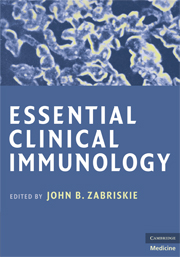Book contents
- Frontmatter
- Contents
- List of Contributors
- 1 Basic Components of the Immune System
- 2 Immunological Techniques
- 3 Immune Regulation
- 4 Immunological Aspects of Infection
- 5 Immunological Aspects of Immunodeficiency Diseases
- 6 Autoimmunity
- 7 Chronic Lymphocytic Leukemia
- 8 Immunology of HIV Infections
- 9 Immunological Aspects of Allergy and Anaphylaxis
- 10 Immunological Aspects of Skin Diseases
- 11 Experimental Approaches to the Study of Autoimmune Rheumatic Diseases
- 12 Immunological Aspects of Cardiac Disease
- 13 Immunological Aspects of Chest Diseases: The Case of Tuberculosis
- 14 Immunological Aspects of Gastrointestinal and Liver Disease
- 15 Immunological Aspects of Endocrine Disease
- 16 Immune-Mediated Neurological Syndromes
- 17 Immunological Aspects of Renal Disease
- 18 Immunological Aspects of Transplantation
- Index
18 - Immunological Aspects of Transplantation
Published online by Cambridge University Press: 18 December 2009
- Frontmatter
- Contents
- List of Contributors
- 1 Basic Components of the Immune System
- 2 Immunological Techniques
- 3 Immune Regulation
- 4 Immunological Aspects of Infection
- 5 Immunological Aspects of Immunodeficiency Diseases
- 6 Autoimmunity
- 7 Chronic Lymphocytic Leukemia
- 8 Immunology of HIV Infections
- 9 Immunological Aspects of Allergy and Anaphylaxis
- 10 Immunological Aspects of Skin Diseases
- 11 Experimental Approaches to the Study of Autoimmune Rheumatic Diseases
- 12 Immunological Aspects of Cardiac Disease
- 13 Immunological Aspects of Chest Diseases: The Case of Tuberculosis
- 14 Immunological Aspects of Gastrointestinal and Liver Disease
- 15 Immunological Aspects of Endocrine Disease
- 16 Immune-Mediated Neurological Syndromes
- 17 Immunological Aspects of Renal Disease
- 18 Immunological Aspects of Transplantation
- Index
Summary
INTRODUCTION
More than fifty years have passed since the first identical twin transplant was performed, and we can now look on organ transplantation as an extremely successful treatment for hundreds of thousands of patients who would otherwise have been doomed to organ failure or to death. This successful kidney transplant between identical twins in 1954, performed at the Peter Bent Brigham Hospital by Dr. Joseph Murray and his colleagues, helped to usher in the field of solid organ transplantation. Within the ensuing decade, this transplant was followed by the first successful transplants from a non-twin living donor and later on from a cadaveric donor. The shortage of donor organs is now the chief stumbling block to further development.
The first twin transplant confirmed that a young, healthy donor could survive with one kidney with no disability, as long as the single remaining kidney was not damaged. Indeed, the donor of the first twin transplant is still alive more than fifty years later. This achievement, which was quickly repeated in a number of other twin transplants, confirmed the surgical aspects of this operation. Two other important observations were made. First, if the patient suffered from an autoimmune nephritis, this could recur in the transplanted kidney. The same disease could also develop in the donor's remaining kidney because of the genetic susceptibility of identical twins to similar diseases.
The immunological obstacles, however, proved to be stubborn. Medawar and colleagues had shown that skin grafts were destroyed by a mechanism that had immune characteristics.
- Type
- Chapter
- Information
- Essential Clinical Immunology , pp. 331 - 348Publisher: Cambridge University PressPrint publication year: 2009

